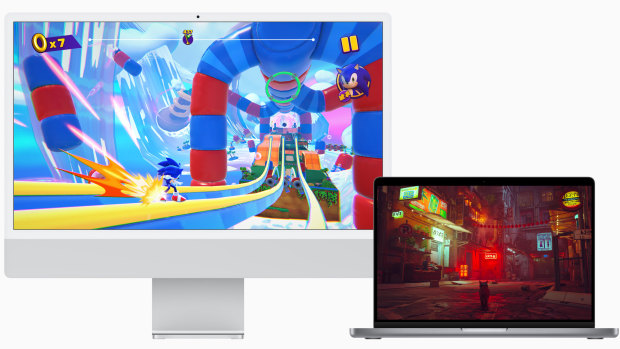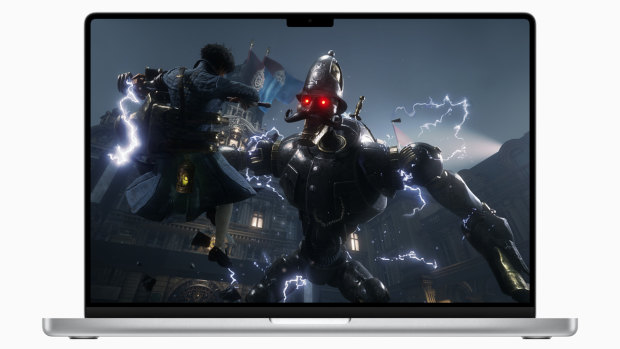
Save articles for later
Add articles to your saved list and come back to them any time.
Apple has big plans for its Mac computers to carve out a larger slice of the half-a-trillion-dollar video games business, pairing powerful new chips with developer tools it hopes will attract the best and brightest.
Games are closely tied to the history of Apple’s home computers, but the modern Mac has largely abandoned the medium until recently. According to the latest data from Steam, the dominant PC games marketplace, around 96.5 per cent of players are on Windows. MacOS users account for just 1.5 per cent, with the remaining 2 per cent on Linux.
Apple wants to make the Mac as popular for gaming as it is for creative work.
From a macro view, addressing this will be vital for Apple for two reasons. First, video games are increasingly important both commercially and culturally, and help inform people’s decisions of what hardware to buy. Second, Apple’s computers are already bumping up against a ceiling when it comes to the creative professional market, having more or less dominated the segment. Video games will be integral to growing their popularity with a more mainstream audience.
Ever since the introduction of the first Apple Silicon chip for Macs, the M1, gaming has become a more prominent part of the company’s sales pitch and unveiling events. All the Macs Apple currently sells use Apple Silicon, with the M2 or M3 in everything from the MacBook Air to the desktop Mac Pro.
Doug Brooks, Apple Mac marketing manager, said this meant all new Macs were ready to provide great gaming experiences out of the box.
“I’m really excited about how much performance it’s brought to our very mainstream high-volume systems … like the new iMac or the 14-inch MacBook Pro,” he said.
“And as we continue to build more and more momentum with gaming, we are just going to find more users being able to tap into that horsepower.”
The M3 specifically, like the A17 Pro chip in the iPhone 15 Pro, has several specific features that benefit professional modelling and graphics production but are also hugely beneficial for games. These include hardware ray tracing for more realistic lighting, mesh shading for generating geometry, and dynamic caching which lets the system more efficiently assign resources between the graphics, processor and memory.
“You’re going to see us continue to push forward and deliver just these incredible capabilities on the Mac. And we’re very excited about that,” Brooks said.
There’s no denying the hardware is capable. On both a high-end MacBook Studio and the latest MacBook Pro I’ve been able to push recent games to high resolutions at more than 100 frames per second. In some situations, they’re more performant than my big Intel-powered Windows tower with its huge Nvidia graphics card. Even the new iMac — with its entry-level M3 and comparatively lower levels or RAM — confidently ran the likes of Lies of P at a level comparable to current game consoles, with the help of Apple’s MetalFX AI scaling.
If big new games consistently came to Mac at the same time as other platforms it would be easy to see their appeal for gaming. But on the contrary, the Mac is starved of mainstream relevant titles. Apple has invested a considerable amount in Apple Arcade, a subscription service that gives access to a library of ad-free, microtransaction-free games on iPhone, iPad, Apple TV and Mac. The lineup includes big names like Sonic the Hedgehog, with a new original 3D adventure in the series released exclusively for Arcade this past week.
Between Apple Arcade and various stores there are a lot of games on Mac, just nowhere near as many as on Windows.
But none of the games on the service hold the cachet of a blockbuster $100 release. The huge majority of those kinds of releases only come to Windows PC and consoles, with some (but not many) eventually being ported to Mac later on.
Leland Martin, Apple software marketing manager, said the company’s efforts are beginning to change this. Apple provides a game porting toolkit that makes it as easy as possible to bring games over from Windows, and now Apple Silicon is standard there are fewer hardware permutations to worry about. Plus, the fact that future games will work across Mac and phones is a major advantage.
“The pieces are coming together in a way that hasn’t happened before. There’s no other place in the world you can buy a blockbuster game once, and play it natively on a smartphone, a tablet and a personal computer,” he said.
“There are tens of millions of Apple Silicon Macs out there. And when you combine that with every iPhone and iPad that also uses that powerful, capable hardware, that number becomes even larger. All of them are capable of running today’s latest demanding games. So we continue to see this tremendous interest from game studios.”
Some major game studios have broken with tradition by confirming launches on the App Store across both Mac and iPhone, including Capcom (Resident Evil), Ubisoft (Assassin’s Creed) and Kojima Productions (Death Stranding), though well after the games have been released on other platforms. And some big 2023 games have Mac-compatible versions on Steam, including Baldur’s Gate 3.
Assuming all Apple’s investment in game-friendly technology and tools does result in a huge increase in gaming on Mac, with major games arriving on day one, the question of how the company monetises it is an interesting one.
Lies of P launched on Mac the same day it arrived on other platforms.
Like Windows, Mac is an open software ecosystem where users can install games from any source they like. Steam is the dominant player, and was estimated to have revenues exceeding $US10 billion ($15 billion) in 2021. Microsoft, despite owning the operating system the bulk of those games run on, wouldn’t have seen any cut of that money.
Instead, Microsoft has diversified its gaming operations on PC. It runs its own app store on Windows selling games, from which it does get a cut, but it also sells the games its own internal studios create (like Halo, Starfield and Forza) on Steam. And it has a subscription service called PC Game Pass where users can pay monthly for a library of games on Windows.
Apple meanwhile does not make its own games. It may tempt some developers to the App Store with cross-purchase iPhone functionality, but gamers will likely stick with Steam since it works across Mac and Windows. Martin said Apple was happy either way.
“We’re seeing titles come to both Steam and the Mac App Store, and we’re seeing games come to the Mac via Steam exclusively. It’s really up to the developer’s choice, and we help them whichever decision they make,” he said.
“This is just the beginning. We’re still in the very early stages, and already we’re seeing great partners and momentum from huge games, that didn’t previously exist on any Apple platform. This is just the first generation of it.”
Get news and reviews on technology, gadgets and gaming in our Technology newsletter every Friday. Sign up here.
Most Viewed in Technology
From our partners
Source: Read Full Article


